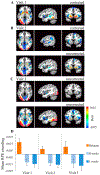Is the encoding of Reward Prediction Error reliable during development?
- PMID: 29777827
- PMCID: PMC7518449
- DOI: 10.1016/j.neuroimage.2018.05.039
Is the encoding of Reward Prediction Error reliable during development?
Abstract
Reward Prediction Errors (RPEs), defined as the difference between the expected and received outcomes, are integral to reinforcement learning models and play an important role in development and psychopathology. In humans, RPE encoding can be estimated using fMRI recordings, however, a basic measurement property of RPE signals, their test-retest reliability across different time scales, remains an open question. In this paper, we examine the 3-month and 3-year reliability of RPE encoding in youth (mean age at baseline = 10.6 ± 0.3 years), a period of developmental transitions in reward processing. We show that RPE encoding is differentially distributed between the positive values being encoded predominantly in the striatum and negative RPEs primarily encoded in the insula. The encoding of negative RPE values is highly reliable in the right insula, across both the long and the short time intervals. Insula reliability for RPE encoding is the most robust finding, while other regions, such as the striatum, are less consistent. Striatal reliability appeared significant as well once covarying for factors, which were possibly confounding the signal to noise ratio. By contrast, task activation during feedback in the striatum is highly reliable across both time intervals. These results demonstrate the valence-dependent differential encoding of RPE signals between the insula and striatum, and the consistency of RPE signals or lack thereof, during childhood and into adolescence. Characterizing the regions where the RPE signal in BOLD fMRI is a reliable marker is key for estimating reward-processing alterations in longitudinal designs, such as developmental or treatment studies.
Keywords: Adolescence; Development; Prediction Error; Reliability; Reward; fMRI.
Copyright © 2018 Elsevier Inc. All rights reserved.
Conflict of interest statement
Conflicts of interest
None.
Figures






References
Publication types
MeSH terms
Grants and funding
LinkOut - more resources
Full Text Sources
Other Literature Sources

